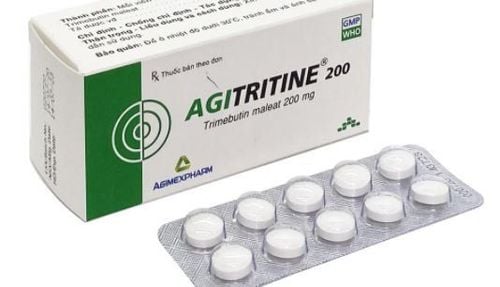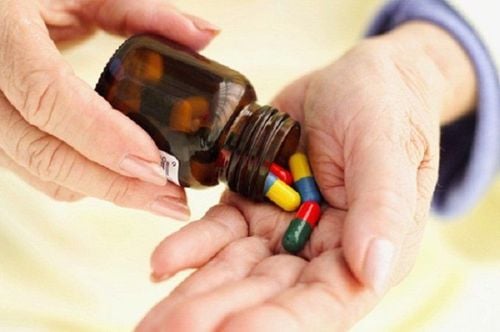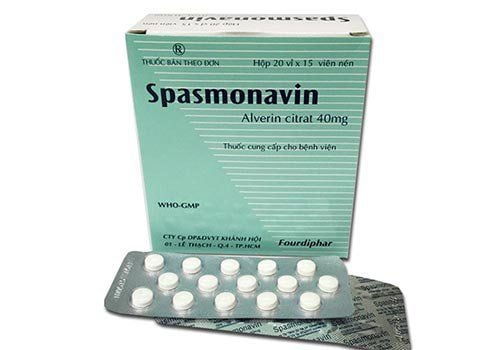This is an automatically translated article.
Domperidone is commonly used to treat symptoms of gastrointestinal disorders. The following article will provide information about the uses, doses and precautions when using Domperidone.
1. What is Domperidone?
Domperidone medicine has the main ingredient Domperidone, which is effective in treating symptoms of nausea and vomiting. Besides, the drug also helps to strengthen the contractions of the stomach and intestines; relieve symptoms of indigestion such as belching, gas, bloating, and upper abdominal pain; relieve symptoms of gastroesophageal reflux disease and esophagitis. Domperidone should not be abused, especially for children because it can lead to poisoning and cause dangerous complications.
Domperidone dosage forms:
Tablets: Domperidone Stada 10mg Oral suspension: Domperidone 30mg or 30ml; Suppositories: Domperidone 30mg; Syringe: Domperidone 10mg or 2ml; Effervescent nuggets: Domperidone 10mg/pack. Indications:
Domperidone is indicated for the short-term treatment of severe nausea and vomiting of various etiologies such as following chemotherapy for cancer, levodopa or bromocriptine induced in the treatment of Parkinson's disease. The drug is rarely indicated for use with a prolonged antiemetic effect or for the prevention of postoperative vomiting; Treatment of symptoms of dyspepsia unrelated to ulcers Symptomatic treatment of gastroesophageal reflux disease; Helps to promote gastric motility in mild paralytic ileus in diabetic patients, after meals due to slow food entry into the intestine. Contraindications:
Domperidone will not be contraindicated in some cases such as:
Patients with hypersensitivity to domperidone Patients with cardiac conduction disorders or heart disease Patients with moderate to severe hepatic impairment Patients taking the combination with drugs that prolong the QT interval, or with strong inhibitors of CYP3A4 (eg, cimetidine, ketoconazole, erythromycin); Patients taking concomitant antiemetics that block nenrokinin-1 receptors in the brain Patients experiencing gastrointestinal bleeding or gastrointestinal perforation Patients with mechanical intestinal obstruction; Patients with prolactin-secreting pituitary tumors (prolactinome) Pregnant women.
2. Dosage and administration of Domperidone
2.1 Dosage for each group of subjects Dosage for adults:
Take 10 - 20 mg/time, divided 3 - 4 times/day but maximum 80 mg/day. Or can put the drug into the rectum with 30 - 60 mg / time, 2 times / day.
Dosage for children :
For children weighing over 35kg, use the same dose as adults.
Treatment of vomiting and nausea:
For children weighing up to 35kg orally: Take about 250 - 500 micrograms/kg body weight/time, divided 3-4 times/day, maximum 2.4 mg/kg/ day; For children weighing 15-35 kg using the rectal route: Use 30 mg/time, divided into 2 times/day (or daily for children put 4 mg/kg into the rectum, divided into several times). Note that the rectal line should not be used for children weighing less than 15 kg. Treatment of gastroesophageal reflux syndrome - oesophagitis, helping to promote gastrointestinal motility:
With the group of infants: Take 100-300 micrograms/kg/time, divided 4-6 times/day. For the group of children from 1 month to 12 years old: Take 200-400 micrograms/kg/time (maximum 20mg/time), divided 3-4 times/day; For the group of children from 12 to 18 years old: Take 10-20 mg/time, divided 3-4 times/day. 2.2 Dosage for other subjects Patients with hepatic impairment: Domperidone is not indicated for use in patients with moderate or severe hepatic impairment, no dose adjustment is required in patients with mild hepatic impairment.
Patients with renal impairment: In patients with severe renal impairment, the half-life of domperidone will be prolonged, with repeated administration the frequency of domperidone tablet dosage form should be reduced to once or twice daily depending depending on the degree of renal impairment and may require dose reduction. Patients on long-term treatment should consult with their physician about regular dosing.
How to use the drug:
Domperidone is used mainly orally, very rarely by injection. Patients are advised to take the drug about 15 - 30 minutes before meals; Parenteral route: It is not recommended to use intravenous drugs for patients because many countries have banned domperidone intravenous injection. Domperidone should be used at the lowest effective dose for the shortest possible time, usually no more than one week. 2.3 Side effects of the drug Rare side effects In female patients can see nipple discharge or breast swelling in male patients, breast tenderness, dry mouth, headache, skin rash, hot flushes, itchy skin, red itchy eyes and painful swelling, menstrual irregularities in women.
Rare side effects After using the drug, the patient has an increased or decreased need to urinate, urinary retention, burning or pain when urinating; altered appetite, increased thirst, difficult bowel movements, diarrhea, heartburn, stomach cramps; language difficulties; feeling dizzy, sleepy, irritable, mentally sluggish, easily falling into a state of anxiety; fatigue, muscle weakness, sluggish performance, leg cramps; palpitations.
These side effects will go away as the body gets used to and responds to the medication. In case the side effects persist or cause discomfort to the patient, it is necessary to immediately notify the treating doctor for advice.
3. Notes when taking Domperidone
People with Parkinson's disease are prescribed domperidone for no more than 12 weeks. In the process of using the drug may appear harmful effects in the central nervous system. If other antiemetic measures used in Parkinson's disease do not work, then domperidone should be used.
People with marked electrolyte disturbances (hypokalemia, hypomagnesaemia) need to be very careful when using. It is necessary to reduce the dose by 30-50% in patients with renal failure and divide the drug into several times a day.
Domperidone is rarely given by injection. In the case of intravenous domperidone administration, extreme caution should be exercised, especially in patients with a history of cardiac arrhythmias or hypokalemia.
Intravenous domperidone can lead to convulsions, acute dyskinesia, ventricular arrhythmias, even cardiac arrest and death. Many countries around the world have banned the use of injectable domperidone.
Above is information about the drug Domperidone. Knowing how to use, the dose will help the treatment process to be effective and optimal for the patient.
Please dial HOTLINE for more information or register for an appointment HERE. Download MyVinmec app to make appointments faster and to manage your bookings easily.













